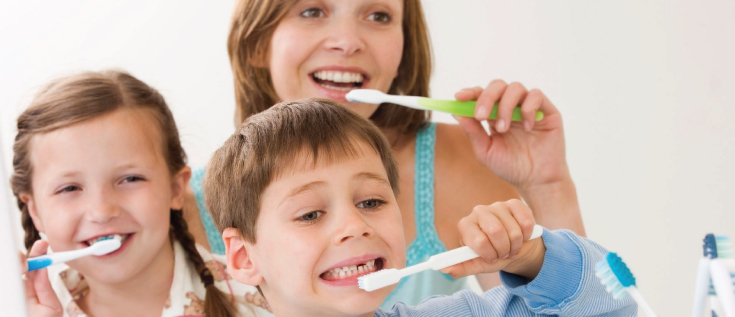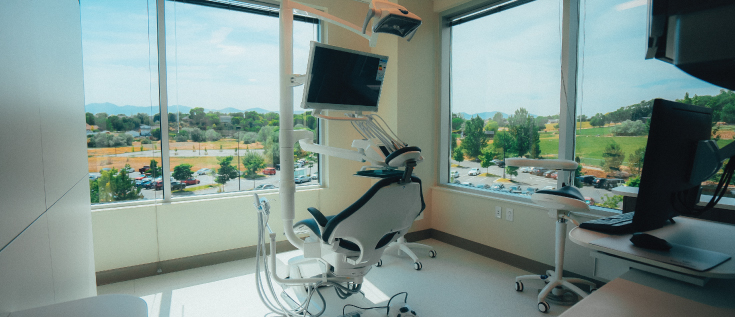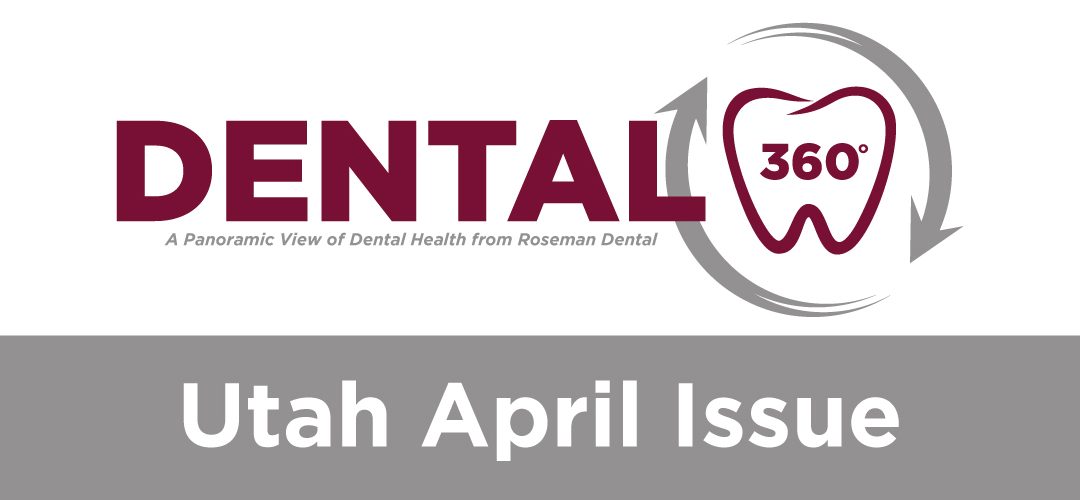
by Roseman Dental | May 11, 2022 | Dental 360, Dental Clinic Blog, Oral Health, Roseman Dental - NV, Roseman Dental - UT
Most people know that they should brush and floss their teeth once or twice daily for good oral health. Knowing and doing are definitely not the same, though. Here are some fun facts you may not have known about flossing.
The first floss was made from silk. Luxurious!
Today, there are many floss choices. Here are some tips for choosing the best floss:
- Wide floss is better than regular for people who have bridgework or spaces between their teeth.
- Waxed floss is the easiest to slide between teeth that are close together.
- Unwaxed floss squeaks when teeth are clean and plaque is gone.

- Bonded unwaxed floss is more likely to tear than waxed floss, but much less than regular unwaxed floss.
- For those that feel challenged by their own manual dexterity, flossing tools can be very helpful!
- Those with braces still need to floss and with an array of tools designed to floss in and around brackets and wires, it is easier than ever before.
Women floss more than men do.
Although more than half of Americans do not floss daily, those who do are more likely to be women. Even if you don’t have time to floss every day, occasional flossing is better than not ever flossing! (Honestly, are you really surprised? I’m not. Ladies are just cleaner.)
Water flossers are not a substitute for flossing.
Water flossers like Waterpik are an effective tool for removing debris that a toothbrush can’t reach, especially with braces. They don’t remove plaque, though, and plaque is the primary cause of gum disease. Only floss can help remove this from teeth between regular cleanings at the dentist.
An inmate once used floss to escape from jail.
In 1994, a West Virginia prison inmate braided dental floss into a rope, scaled the wall, and escaped. Here’s the right way to use floss that doesn’t involve breaking any laws:
- Break off a piece about as long as your forearm and wind all but about four inches around one of your middle fingers.
- Wind the tail end around a finger of your other hand.
- Stretch the floss tightly with about an inch between your fingers and guide it down between your teeth using a gentle back-and-forth motion.
- At the gumline, slide the floss gently down between the gum and tooth until there is resistance.
- With the floss against the tooth, gently scrape the side of the tooth as you move the floss away from the gum line.
Floss is the best weapon in the fight against plaque.
Plaque and food debris stick to teeth and gums and lodge between teeth, sending an open invitation to the bacteria that cause gum disease. Floss protects the mouth from all that bacteria by removing plaque and debris.
Even the best flossing habits aren’t a replacement for regular dental checkups. Make an appointment with Roseman Dental to keep that smile shining.

by Roseman Dental | May 11, 2022 | Dental 360, Dental Clinic Blog, Oral Health, Roseman Dental - NV, Roseman Dental - UT
One of the biggest advantages to living in the digital age is the overwhelming amount of information that is just a click away. However, with so much discussion regarding almost every topic imaginable, it is easy to understand why so many rumors and myths get passed around. Since the dental arena is not immune to perpetual misinformation, here are three common myths debunked:
Dental Myth #1
A fancier or more expensive toothbrush results in cleaner, healthier teeth.
The Truth
It is not the type of toothbrush you use, but the manner in which you use it that makes all the difference. Brushing twice a day for two minutes at a time is the key to healthier teeth and gums. This can be easily accomplished whether you opt to use a simple, soft bristle manual toothbrush, or a higher-end electric one. The most important factor is to be comfortable with your selection and use it on a consistent basis.
Dental Myth #2
The harder you brush, the better your results.
The Truth
Brushing your teeth harder does not improve your oral health. In fact, it can have potentially damaging effects! Excessive brushing with aggressive force can lead to enamel loss and gum recession, which can ultimately expose roots and cause sensitivity and tooth decay. If you are unsure if you are a harsh brusher, talk with your dentist so they can assess your routine and provide helpful suggestions. Part of an assessment by a dentist involves measurement and scoring of any potential gum recession. These measurements are taken at each visit and compared against each other to identify long-term recession.
Dental Myth #3
Regular brushing eliminates the need for regular dental cleanings.
The Truth
Plaque, a biofilm with a soft mashed potato-like consistency, begins to form on your teeth within 20 minutes after eating. If it isn’t brushed away within eight hours, it hardens into tarter that brushing cannot remove. Tarter build-up leads to gum disease and tooth decay. Only a dentist or dental hygienist will have the tools necessary to properly and effectively remove tarter from the teeth.
When it comes to oral health, false information can be damaging. The most important way to make your dental health a priority is by seeking out a reputable dentist who can dispel myths and provide you with the facts. Your mouth will thank you for it.

by Roseman Dental | May 10, 2022 | Dental 360, Dental Clinic Blog, Dental School, Oral Health, Roseman Dental - UT
The College of Dental Medicine at Roseman University of Health Sciences has opened a new state-of-the-art clinical floor of Roseman Dental, the clinical practice of Roseman University College of Dental Medicine, South Jordan, Utah location.
This clinical floor is dedicated to Team-Based Education, which is a new education model that focuses on team practice rather than the traditional single-practice model widely used throughout the United States.
As an expansion to the existing Roseman Dental clinical space, the Team-Based Education clinical floor shares the same high-quality patient-centered operating procedures, general and specialty dentistry services, and affordable pricing.
However, there are very distinct differences between the two clinical spaces. In the existing clinic space, the faculty dentist, dental hygienist, and dental assistants oversee the students in providing direct patient care and treatment while students fill the support positions.
The Team-Based Education clinical floor puts a fresh perspective on this traditional teaching model. The new model allows the faculty dentist and dental hygienist to directly provide team-based general dentistry care to patients and teach students their initial procedures in the clinic.
“Since the pandemic began, we have seen a higher demand for flexible healthcare service,” said Dr. Frank Licari, Dean of the Roseman University College of Dental Medicine. “There has been an expansion of urgent care clinics, telemedicine and drive-thru testing and vaccination facilities. Dental practices will also have to evolve to meet patient demands that want more convenient hours and services. We are dedicated at Roseman to prepare our graduates to be successful in that new dental practice environment.”
Dental assistants are more actively engaged in providing direct chairside assistance to the providers. Students continue to rotate and train through all support positions, including dental assistant and hygienist, emphasizing learning how to treat a volume of patients as a dentist, thus creating a student “Team-Based” educational model and service delivery in a clinical setting.
This updated perspective is the vision of an educational model that prepares graduates for a future-ready group practice environment. As such, Roseman is developing a futuristic faculty educator and a highly efficient person-centered care delivery system in which student learning and assessment occur without compromising overall patient care outcomes.
Each team has eight students and one faculty dentist (Team-Based Educator) to treat assigned patients. The faculty dentist is accountable for the patients progressing through treatment and actively interacting with students by demonstrating and providing probing questions to assess student knowledge and progress through competence.
“This team-based education model will lead dental practices to serve a higher volume of patients per day,” Dr. Licari said. “Our students now see six to eight patients a day, compared to the traditional teaching model which students could only see two patients a week.”
Students are paired in teams based on the provider’s patient needs and skill level, and all procedures have a recommended time interval for completion. The vision and significant focus of the clinic are to provide person-centered care at maximum efficiency. Efficiency is collected via integrated technology throughout the clinic and assessed under specific quality control measures.
As part of Roseman’s commitment to graduate future-ready practitioners, the Team-Based Education clinical floor is significantly focusing on technology integration through all aspects of the clinic. The clinic is equipped with collaborative student workspaces with large interactive digital screens, digital signage, scheduling displays, etc. It has built-in innovative Bluetooth technology with data-collecting sensors to optimize operational efficiency, student education, and patient care. Patient appointments are monitored for efficiency, timeliness, and overall patient satisfaction.
Roseman believes the Team-Based Education clinical floor’s educational model is the future of dental education and will serve as a model moving forward.

by Roseman Dental | Apr 13, 2022 | Dental 360, Dental Clinic Blog, Roseman Dental - UT
Spring has sprung! In this April issue of Dental 360°, you’ll learn about preventing dental and facial injuries during sports, picking the right toothbrush, and the different special fields of dentistry. And big news! We’re excited to announce that our Give Kids a Smile® event has been rescheduled to May 6! Sponsored by Marathon Petroleum Corporation and the American Dental Association, children under 18 years old will receive free dental screenings and cleanings, plus a voucher for a free comprehensive exam, X-rays, sealants and up to $100 of additional care. Find out more and make plans to attend!
Roseman Dental’s Dental 360° is a monthly e-newsletter. Each month you’ll receive a panoramic view of dental health. Dental health is key to your overall health and here at Roseman Dental, we are dedicated to improving not only your mouth, but your whole self. At our clinic we have an excellent team of licensed dentists, dental residents and students, and dental assistants and hygienists all focused on you and your family’s oral health. We offer comprehensive care, are a one-stop shop for all your dental needs and offer dental care at a cost typically lower than what you would find at a traditional dental office. Roseman Dental has been serving its community since 2011 and we look forward to continuing to serve you and your family.
We hope you find Dental 360° helpful and informative. We look forward to connecting with you each month.
Dental 360° April Articles
Guarding Against Dental and Facial Injuries – National Facial Protection Month
Specializations for Those Interested in Dentistry
How to Choose the Best Toothbrush
The Risks and Benefits of Using Aspirin





